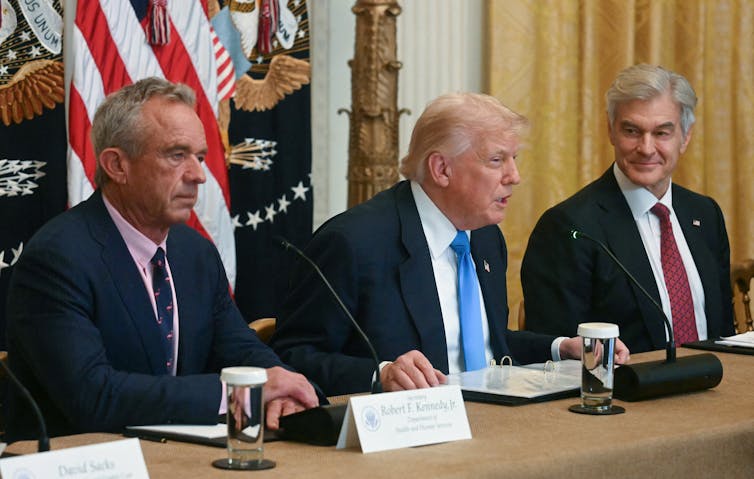Scott L. Montgomery, University of Washington
President-elect Donald Trump has sparked diplomatic controversy by suggesting the U.S. needs to acquire Greenland for reasons of “national security” and refusing to definitively rule out using military force to do so. Greenland, a self-governing Danish territory, “is not for sale,” said Denmark’s prime minister, Mette Frederiksen.
Trump’s interest in Greenland is not new. He first expressed interest in the territory in 2019, but it never developed into any action.
Whether or not Trump has actual plans this time around to advance any attempt in Washington to own Greenland is far from clear. But given the incoming president’s repeated statements and invocation of national security, it’s worth considering what strategic value Greenland might actually have from the perspective of the U.S.’s geopolitical priorities.
As a scholar of geopolitical conflicts involving natural resources and the Arctic, I believe Greenland’s value from an international political perspective can be viewed in terms of four fundamental areas: minerals, military presence, Arctic geopolitics and the territory’s potential independence.
A matter of minerals
Greenland’s most valuable natural resources lie with its vast mineral wealth, which holds real potential to advance its economy. Identified deposits include precious metals such as gold and platinum, a number of base metals – zinc, iron, copper, nickel, cobalt and uranium – and rare earth elements, including neodymium, dysprosium and praseodymium. A detailed 2023 summary published by the Geologic Survey of Denmark and Greenland suggests new deposits will be found with the continued retreat of the Greenland Ice Sheet.
Greenland’s rare earth resources are particularly significant. These elements are essential not only to battery, solar and wind technology but also to military applications. If fully developed, the Kvanefjeld – or Kuannersuit in Greenlandic – uranium and rare earth deposit would place Greenland among the top producers worldwide.
During the 2010s, Greenland’s leaders encouraged interest from outside mining firms, including leading Chinese companies, before finally granting a lease to the Australian company Energy Transition Minerals (formerly Greenland Minerals Ltd).
When China’s Shenghe Resources took a major share in Energy Transition Minerals, it raised red flags for Denmark, the European Union and the U.S., which felt China was seeking to expand its global dominance of the rare earth market while reducing Europe’s own potential supply.
The issue was put to rest in 2021 when Greenland’s parliament banned all uranium mining, killing further development of Kvanefjeld for the time being. That same year saw the government also prohibit any further oil and gas activity. Predictably, a majority of mining companies have subsequently steered clear of Greenland due to perceived concern of any investment being jeopardized by future political decisions.
Fears of China abroad
China’s interest in Greenland stretches back at least a decade.
In 2015, Greenland Minister of Finance and Interior Vittus Qujaukitsoq visited China to discuss possible investment in mining, hydropower, port and other infrastructure projects. One firm, China Communications Construction Company, bid to build two airports, one in the capital, Nuuk, the other in Ilulissat.
Another Chinese firm, General Nice Group, offered to purchase an abandoned Danish naval base in northeastern Greenland, while the Chinese Academy of Sciences asked to build a permanent research center and a satellite ground station near Nuuk.
None of this sat well with the first Trump administration, which put pressure on Denmark to convince Greenland’s government that a significant, official Chinese presence on the island was unwanted. The Danes and Greenlanders complied, rebuffing Chinese attempts to invest in Greenland-based projects.
The Trump administration, in particular, viewed China’s interest in Greenland as having hidden commercial and military motives, concerns that continued under the Biden administration in its recent lobbying of another Australian mining firm not to sell any of its Greenland assets to Chinese companies.
Long-standing US interest
The U.S. has had a long-standing security interest in Greenland dating from 1946, when it offered Denmark US$100 million in gold bullion for it. The Danes politely but firmly declined, with their foreign minister saying he didn’t feel “we owe them the whole island.”
In the early 1950s, the U.S built Thule Air Force Base 750 miles (about 1,200 kilometers) north of the Arctic Circle. Originally a missile early warning and radio communications site, it was transferred to the newly formed U.S. Space Force in 2020 and renamed Pituffik Space Base in 2023.
The northernmost military facility of the U.S., Pituffik has updated radar and tracking capabilities to provide missile warning, defense and space surveillance, and satellite command missions. While it also supports scientific research focused on the Arctic, the base is intended to increase military capabilities in the Arctic region for both the U.S. and its allies.
The base has the ability to track shipping as well as air and satellite positions, giving it both real and symbolic importance to American strategic interests in the Arctic. As a result, much of the U.S. foreign policy establishment, not just those in Trump’s orbit, view any notable Chinese presence in Greenland, whether temporary or permanent, with concern.
Geopolitics of the Arctic
Greenland is geographically situated between the Northern Sea Route and the Northwest Passage, two Arctic shipping routes whose importance is growing as sea ice shrinks. By around 2050, a Transpolar Sea Route is likely to open through the central Arctic Ocean, passing Greenland’s eastern shores. Furthermore, the island is the basis of Denmark’s sovereignty claim to the North Pole – rivaled by claims by Russia and Canada.
While international law recognizes no national sovereignty in international waters, that has done little to end the diplomatic tug-of-war over the pole. The matter is far from trivial: Sovereignty would give a country access to potentially significant oil, gas and rare earth resources, as well as superior scientific and military access to the future Transpolar Sea Route.
Yet, this dispute over ownership of the North Pole is only one part of the geopolitical struggle for offshore territory in the region. Russia’s growing militarization of its enormous coastal area has been countered by NATO military exercises in northern Scandinavia, while China’s own moves into the Arctic, aided by Moscow, has seen the launch of several research stations supported by icebreakers and agreements for research and commercial projects.
China’s government has also asserted it has rights in the region, for navigation, fishing, overflight, investment in oil and gas projects, and more.
Greenland for Greenlanders?
All of these factors help decipher the realities involved in the U.S.-Denmark-Greenland relationship. Despite Trump’s words, I believe it is extremely unlikely he would actually use U.S. military force to take Greenland, and it’s an open question whether he would use coercive economic policies in the form of tariffs against Denmark to give him leverage in negotiating a purchase of Greenland.
Yet while Trump and other foreign policy outsiders view Greenland through an external strategic and economic lens, the island is home to nearly 60,000 people – 90% of them indigenous Inuit – many of whom treat the designs of foreign nations on their territory with skepticism.
Indeed, in 2008, Greenland voted to pursue nationhood. The island receives an annual subsidy of 500 million euros ($513 million) from Denmark, and to further economic independence, it has sought foreign investment.
Interest from China has accompanied Greenland’s moves toward independence, backed by Beijing’s strategy to be an Arctic player. The thinking in Beijing may be that an independent Greenland will be less shackled to NATO and the European Union, and as such, more open to investment from further afield.
Ironically, Trump’s recent comments have the potential of achieving something very different than their aim by encouraging Greenland’s prime minister, Mute Egede, to propose a referendum in 2025 on full independence.
“It is now time for our country to take the next step,” he said. “We must work to remove … the shackles of colonialism.”
Scott L. Montgomery, Lecturer, Jackson School of International Studies, University of Washington
This article is republished from The Conversation under a Creative Commons license. Read the original article.





















































